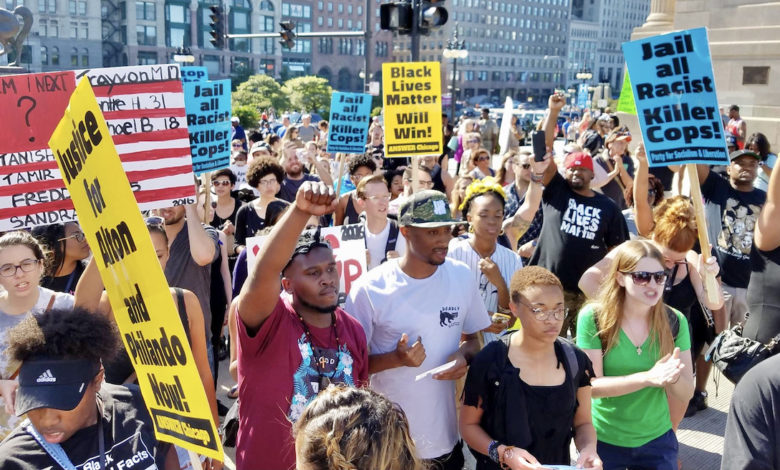
“The most consistent lie of racism is the lie that it benefits most white people. …” Rev William Barber, co-chair of the Poor Peoples Campaign
Capitalism throughout the history of the United States has been distinguished by the incredible intensity of racist oppression. The genocidal dispossession of Native nations, the enslavement of tens of millions of Black people, and the super-exploitation of successive waves of immigrant workers from every part of the world were all essential factors in the rise of the U.S. ruling class to its position of global dominance — and justified using the most vile white-supremacist ideology. Ending this regime of racial oppression is clearly key to ending the capitalist system. And, unsurprisingly, as a consequence there are a whole range of actions taken by the ruling class to misdirect people from this key task.
Divide-and-conquer is a tactic as old as class society itself — where the elites at the top encourage the bottom 99% to fight over the crumbs that fall from their table.
Today it is the “zero sum” — the Big Con — working-class and oppressed people must fight each other over the same tiny piece of the pie. Zero sum means that our little piece of the pie will never grow — that any gain for one must equal a loss for another.
Conservative think tanks do not like zero sum if it means the working class gets more and the capitalists get less. They do not want it exposed that the huge increase in wealth of the already rich is at the expense of all workers — Black, Native, Latino, Asian, white — whose labor produces all value.
No, to the right-wing think tanks “zero sum” means a “decrease in anti-black prejudice has been offset by an increase in anti-white prejudice … that rising immigration threatens the economic well-being of North American employees … and that the decrease in gender discrimination against women has been offset by an increase in discrimination against men” and so on, according to a recent article in Science Advances.
Zero sum undermines worker solidarity
Heather McGhee, in the book “The Sum of Us: What Racism Costs Everyone and How We Can Prosper Together,” take this further. She explains, “The logical extension of the zero sum story is that a future without racism is something that white people should fear because there will be nothing for them in it.” In fact, the zero sum narrative leaves no room for solidarity by spreading competitive distrust among the entire working class.
The zero sum construct is a product of well-funded right-wing think tanks devoted to propagating lies and deceit: the Charles Koch Foundation, Heritage Foundation, Cato Institute, American Enterprise Institute, RAND Corporation, and Freedom Works, to name a few.
Right-wing think tanks are not required to disclose donations, so available sources are limited. However, the RAND Corporation alone “received over $1 billion between 2014-2019, accounting for approximately 95 percent of its funding that the report tracked. Nearly all the money came from the U.S. Department of Homeland Security ($110 million), the U.S. Army (over $245 million), and the U.S. Air Force (over ($281 million).”
Where does this money actually come from? We pay it, of course.
According to McGhee, “The plutocrats … aim is to cut off any senses of empathy white people who are struggling might develop for the also-struggling people of color.”
A line sold by the wealthy
The chairperson of the board of the Color of Change, a racial justice organization, McGhee is very clear: “I am well aware that the ledger of racial harm is nowhere near balanced … but the zero sum paradigm is no longer sparing millions of white Americans from the degradations of American economic life. …. the zero sum is a story sold by wealthy people for their own profit.”
Who are these “wealthy people”?
There are more billionaires than ever. As of March 2020, the average net worth of the 25 richest people in the United States was $43.45 billion. A year later, their average net worth is $65.58 billion — an over 50% increase in wealth.
How racism rebounds on white working class
“The Sum of Us” includes many examples of how racism not only inflicts great damage on oppressed people, but always rebounds on the white working class as well. The following examples are just the tip of the iceberg of how racism greases the wheels of exploitation of the entire working class.
Universal health care. President Harry Truman in 1947 proposed universal health care at a time when very few workers had any health coverage at all. Racist red-baiting led by Southern segregationists kept the proposal from ever getting off the ground. They feared that federal involvement in health care might lead to federal action against segregation.
The American Medical Association also weighed in on the red-baiting, calling Truman’s plan “socialized medicine” and saying that the Truman administration were “followers of the Moscow party line.”
“To be clear, the beneficiaries of Truman’s universal coverage would have been overwhelmingly white. This was the beginning of the end of New Deal reforms,” says McGhee.
Voting rights. The poll taxes, literacy tests, and registration rules in southern states were used to prevent the freed Black population, as well as the poor white population from voting, disempowering both.
Poll taxes “required cash of poor white, Black and Indigenous people who were often sharecroppers with little cash to their names. … In many places the poll tax continued to work almost as effectively to disenfranchise poor white people as it did Black people. … The turnout of eligible white voters plummeted. … In the presidential election campaign of 1944, when the national turnout averaged 69%, the poll tax states managed a scant 18%,” writes McGhee.
Housing crisis. When the housing crisis exploded in 2008, 5.6 million homes were foreclosed. Black homeowners were the first targets. Long denied fair housing, in the recent era of rampant bank deregulation, they had been offered low-interest housing loans whose risky nature was concealed from them. Contracts had hidden clauses with variable interest rates that suddenly rose through the roof, and could not be paid.
When the housing bubble burst many financial institutions went bankrupt from packaging and selling these risky loans as securities. In a racist “blame the victim” campaign, the corporate media was quick to paint everyone who suffered in the crisis, including even the banks, as the victims of Black homeowners who could no longer pay their mortgages.
McGhee explains that “… there is no question that the financial crisis hurt people of color first and worst. And yet the majority of the people it damaged were white.”
What a multi-racial movement can do
In this ground-breaking book, McGhee promotes the “Solidarity Dividend,” the idea that a “multi-racial coalition” can win gains for working-class people — gains the zero sum approach of racist and anti-worker politicians have always tried to prevent.
She found a moving example in Maine, which has “one of the whitest and oldest populations in the country.” Residents of Maine with French ancestry, “Francos,” who still experience discrimination, found common cause with French-speaking African immigrants from Somalia, the Congo, Chad, Djibouti and Sudan. Together they built a multinational coalition that enabled Maine to be “the first state in the nation to vote to expand Medicaid by ballot initiatives over the governor’s repeated refusal.” What these groups could not accomplish alone was won by fighting together.
Most recently, the massive multinational Black Lives Matter demonstrations that swept the country last year in a rebellion against racism and police murder got its strength from the participation of people from every community. Black, Latino and white, in large cities and small towns, showed the way forward as the suffering from COVID-19 and the capitalist economy continued with no real end in sight.
Progressive movement and zero-sum politics
By exposing the zero-sum formulation as a false description of reality deliberately constructed to confuse and divide, McGhee provides both the ammunition and the reason for diverse sections of the working class to seek each other out and work together for common gains.
There is much food for thought here for those already in the struggle. Some even in the progressive movement focus primarily on the differences between white and oppressed workers, missing so much of what we have in common and what stands to be gained if we struggle together.
The perspective of a solidarity dividend is crucial to organizing to win. McGhee has helped chart a course of multinational working-class unity that can both end racism and reorganize society for the benefit of all.






